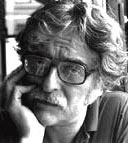 |
→ August 2004 Contents → Column
|
Nuts and Bolts
August 2004
|
 |
|
A long time ago I showed my 35mm Contax to the 4x5-shooting AP photographer who started me in this somewhat dubious profession. His reaction was predictable: Can a camera that small be any good? I've spent the last month hearing the digital equivalent of that very question from friends and readers who have been using 6MP SLRs for some time. Can those little, compact 8MP cameras be any good? There are five of these new cameras. They all use the same Sony CCD sensor and have a number of common qualities. I only have experience with one, the Canon Powershot Pro 1, and one 6MP SLR, the Canon 10D, but my experience may be useful to photographers using other 8MP compacts and comparing them to other 6MP SLRs. For openers, the Powershot is approximately 4 1/2 x 3 x 3 1/2 inches and weighs in at around 19 ounces. Compare that to a full-sized SLR body with a decent zoom. And, remember, the Powershot zoom is the equivalent of a 28-to-200mm zoom on a larger SLR. Advantage number one: an awful lot of camera that can be carried easily and not attract any more attention than any small "amateur" camera. The various audio bells, whistles and signals can be turned off to make it attract even less attention. With all the features that you expect on a professional camera, from a variety of auto focusing and auto metering settings (and manual if you want that) and a variety of electronic imaging controls, there is little to differentiate the Powershot's potential uses from that of the larger camera. But there are some. The viewfinder is electronic. Some folks prefer the conventional viewfinder on the SLRs, like the Canon 10D. Sometimes I slip a Leica brightline finder into the Powershot accessory shoe. I really like this combination, but I am thought of as a little strange. The buffer is smaller and frames per second are slower than you would find on the SLR. The noise from the smaller censor limits the "film speed" at which you can shoot without getting objectionable noise in the image. For me, shooting at 400 with the Powershot is an "emergency" procedure. By using the noise controls for RAW images in Photoshop CS, I can get an acceptable image. (Yes, I'm one of those people who shoots in RAW whenever possible.) But for high speed, low light work, the physically bigger sensors in cameras like the 10D, along with the availability of higher speed lenses than the 2.4/3.5 zoom on the Powershot, make the bigger cameras better for available light work. Having grown up shooting news on Kodachrome EI 25 and 64, the fact that I get my best image quality with the Powershot at film speeds of 50 and 100 doesn't bother me. It's just that I'm back to bounce flash, a soft but bright light that mimics natural light, when I use the Powershot. The transition between smooth, noise-free images to ones in which the noise is clearly visible is gradual as film speed is increased. What is acceptable is effected by variables such as print size and from what side of the bed you got up this morning. My attitude is simply to use the slowest "film" speed I can that will allow me to do the job properly. I'm aided in this by the generous depth and high quality of the "L" 7.2-to-50.8mm lens. I rarely shoot with the lens stopped down smaller than f/4 and this keeps my film speed down and my shutter speed up. Making a series of full-frame prints on 13x19-inch paper and viewing the prints at nose-near distance, I could distinguish between 10D control image EI 200 and similar images made at all available speeds by the Powershot Pro 1. A little distance, arm's length, between me and the print and the major difference between the 50-speed Powershot and the 200-speed 10D became a smoother transition of tones over a longer range of brightness with the bigger camera. I spent a lot of time squinting at test images to see this difference. Only one other person I showed the large test prints to could see a difference. She thought the mini was sharper. In other words, use it correctly and there is little difference in image quality between the little camera and the big camera. But there is a huge difference in portability and noticeability. My feeling is that, over time, many photographers will end up with a kit that consists of one of these mega minis and some giant SLR whoppercamera with double-digit MPs. The intermediate camera will be relegated to "backup body" by professionals who realize any camera can shut down and refuse to work just because it's feeling mean.
© Bill Pierce
Contributing Writer
|
|
Back to August 2004 Contents |
|